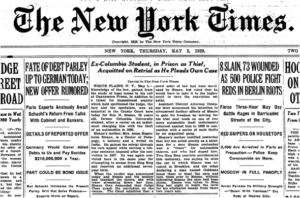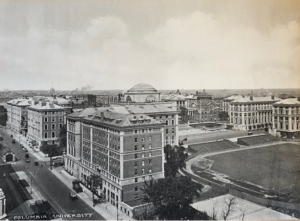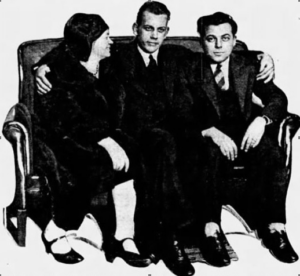Stranger Than Fiction
March 2024
Wayward Son
by Dean Jobb

There seemed to be little doubt the jury would convict Roy Sloane, an inmate doing a ten-year stretch for auto theft, of hiding a weapon in his cell. Guards at New York State’s Sing Sing prison discovered the turning knob of a radiator valve that had been filed down and fashioned into a set of brass knuckles. And when the case went to trial in a White Plains courtroom in 1927, Sloane fired his court-appointed lawyer. Ignoring the adage that those acting as their own lawyer have a fool for a client, he declared he would conduct his own defense.
What followed, noted a reporter for the New York Times, was a legal battle “almost without precedent.” Dressed in his drab prison uniform, the well-spoken, twenty-two-year-old former Columbia University student grilled the prosecution’s witnesses. He took the witness stand and conducted a question-and-answer session with himself. “He was as full of tricks,” the Times reporter claimed, “as any Houdini.”
The valve knob, he testified, was not a weapon. He had modified it to pry open the lock on his cell before abandoning the idea of staging a break-out. And he scoffed at the notion that prisoners would resort to making their own weapons. “It’s easy to get a pistol in Sing Sing,” he assured the jury. To prove that inmates had access to contraband, he produced a screwdriver and two chisels from his clothing with the aplomb of a magician pulling rabbits from a hat. The guards who had searched him twice before bringing him into the courtroom were astonished. The judge was incredulous.
“Is there anything you can’t get in Sing Sing?” he demanded.
“Yes,” Sloane replied, without missing a beat. “Liberty.”
The press ate it up. “Learns Law in Cell, Tries His Own Case,” read one headline. Newspapers dubbed him the “intellectual car thief.” Would Sloane’s showmanship and a crash course in the law be enough to win his freedom? And could a man clever enough to talk his way out of prison escape from a life of crime?
Roynar Herbert Sloane was born in 1905 in Washington, D.C., where his father Mersene, a transplanted Minnesotan with a large library of religious books, worked in the U.S. Census Bureau. His mother, Anna Bogenholm Sloane, a writer who claimed to be a descendant of Swedish royalty, established a school to teach handicrafts and worked as a researcher for the Department of Labor.

Sloane was “an inventive, ingenious and nimble-witted youngster,” by one account. By the time his parents divorced in 1919, he was also demonstrating an aptitude for breaking the law. By age sixteen he had racked up a juvenile record for forgery, housebreaking, and multiple counts of joyriding. Arrested behind the wheel of a stolen car in the summer of 1921, he wound up in a reformatory. After his release he studied engineering at the Carnegie Institute of Technology in Pittsburgh, but was again caught stealing cars and sent back to a reformatory.
By the mid-1920s Sloane was living in New York City with his mother. They were both enrolled at Columbia University—he was taking chemistry courses, she was completing a doctorate. Days after Anna Sloane sailed for India in the fall of 1926, to work as a teacher, detectives arrested her son for trying to sell a stolen car. Released on bail, Sloane immediately stole another car in Mount Vernon, NY and was caught driving it through Brooklyn. Over the previous two years, the police claimed, he had stolen and sold more than twenty automobiles—all of them Nash models, his preferred target—and used the proceeds to cover his tuition and living expenses. Convicted of grand larceny, he was sentenced to ten years. Sloane, the Brooklyn Daily Eagle wisecracked in its report on the case, had earned his degree—“a court degree.”
Sloane, now Inmate 79699, was locked up in Sing Sing—about thirty miles “up the river” from Manhattan, on the east bank of the Hudson—in March 1927. The prison official who filled out his intake form listed his occupation, ironically, as “Auto Salesman.” Within six months, what looked like homemade brass knuckles were found in his cell and he was in the White Plains courtroom, fighting to avoid more prison time.
Sloane’s powers of persuasion almost worked. The jury was deadlocked for six hours before delivering a compromise verdict: guilty, with a recommendation for mercy “on account of his youth and his apparent ability.” The judge, William Bleakley, rejected the call for leniency and imposed the maximum penalty, an additional seven years. If he served his full sentence, he would be almost forty by the time he was released. Sloane, however, had a plan to walk out of Sing Sing long before then.

After months of poring over law books in his cell, Sloane filed a motion demanding a new trial on the charge of grand larceny. He produced affidavits from two Sing Sing inmates who confessed that they had stolen the cars. Sloane, they claimed, had been duped into delivering them and had no idea they were stolen. It was enough fresh evidence to justify a new trial in May 1929.
Sloane conducted his own defense and faced a new judge, Frederick Close. The courtroom was packed with spectators eager to see the self-taught lawyer in action. Edward Snyder, one of the inmates who exonerated Sloane, testified that a fence named Albert Goldman had recruited him to steal cars. Sloane was hired to sell them but “he was just a chump” who “thought it was legitimate,” Snyder explained. The second inmate, Frank Hawks, told the same story. Sloane’s mother, Anna, was back in the U.S. and he called her to the witness stand. Her son had introduced her to Goldman as his “boss,” she testified, and she believed the car-selling business was legitimate. Before she left for India, she added, Goldman had promised her “he would take good care of her son.”
“You’re too bright to be behind prison bars,” said the judge who released him. “Congratulations. Stay out, now.”
“I think it did me good,” Sloane told reporters when asked about his time in prison. “I have no resentment against anyone.” He moved into his mother’s flat in the Bronx. His legal knowledge earned him a job as a clerk in Thornton Banks’s New York law firm. He claimed to have invented a new aircraft component while in prison and he hoped to form a company to produce it.
Sloane’s new life as a law clerk, inventor, and poster boy for beating the system lasted all of two months. In February 1931 three men burst into a Fifth Avenue jeweler’s shop, held the employees at gunpoint, and scooped up jewelry worth $8,000. Spooked by a passing siren, the trio ditched the loot but two of the robbers were arrested before they could flee the building. One of them was Sloane. He posted $20,000 bail and was released as he awaited trial.
Three months later, shotgun blasts were heard outside the Mad Dot Boat Club, a Manhattan speakeasy. The gunman escaped in a car moments before a police officer found Sloane slumped on the pavement. He had been shot twice and died within an hour. A search of his pockets yielded a trove of suspicious items—a false moustache, a fake detective’s badge, a forged driver’s license—and the keys to a stolen Nash parked nearby. One of the newspapers that had made him a celebrity offered a headline as his epitaph: “Sloane, on Road to Success, Chose Crooked Path Instead.”
Soon after his death, Anna Sloane published a series of newspaper articles defending her “wayward boy.” He was “far too ambitious to be a criminal,” she insisted, and “his soul was great and generous.” She blamed her ex-husband, a religious fundamentalist and “a tyrant of the mind,” for being too strict when he was young, fueling Roy’s rebellious nature and his “immeasurable recklessness.” She took credit for his cleverness, however, because she had read books on science and engineering during her pregnancy because she believed the information would be transferred to her unborn son. While she claimed to have been a positive influence as a parent, shortly before her death in 1940 she was denounced as a Nazi sympathizer—she had reached out to Hitler’s advisors with a plan to unite the Ku Klux Klan and other U.S. hate groups.
The police chalked up Sloane’s murder to a gangland hit. There was speculation he was mixed up with bootleggers or was about to implicate others in the botched jewelry robbery. Sloane, in a letter written to his mother shortly before he died, revealed that a “gang leader” was plotting to kill him. His murder, however, was never solved.
———
Dean Jobb’s new book, A Gentleman and a Thief: The Daring Jewel Heists of a Jazz Age Rogue (Algonquin Books), will be released in June. It’s the incredible true story of Arthur Barry, who charmed the elite of 1920s New York while planning some of the most brazen jewel thefts in history. For more on this and his other true crime books, find him at deanjobb.com.
Copyright © 2024 Dean Jobb
